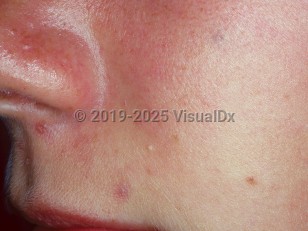Naso-orbital-ethmoid fracture
Alerts and Notices
Important News & Links
Synopsis

Naso-orbital-ethmoid fractures are typically associated with severe maxillofacial trauma. Motor vehicle collisions are the most common cause. As the name implies, fracture to these structures potentially results in nasal deformity, obstruction, injury to the orbit, eyes, and supporting structures. The anterior skull base may also be involved.
These fractures typically require surgical intervention. Surgical repair may be highly complex, with the potential for long-time disfigurement from inadequately repaired injuries. Potential long-term complications include sinusitis, vision and smell impairment, and cerebral spinal fluid leaks.
These fractures typically require surgical intervention. Surgical repair may be highly complex, with the potential for long-time disfigurement from inadequately repaired injuries. Potential long-term complications include sinusitis, vision and smell impairment, and cerebral spinal fluid leaks.
Codes
ICD10CM:
S02.2XXA – Fracture of nasal bones, initial encounter for closed fracture
S02.2XXB – Fracture of nasal bones, initial encounter for open fracture
SNOMEDCT:
103061000119109 – Closed fracture of naso orbital ethmoid
11304561000119105 – Open fracture of naso orbital ethmoid
S02.2XXA – Fracture of nasal bones, initial encounter for closed fracture
S02.2XXB – Fracture of nasal bones, initial encounter for open fracture
SNOMEDCT:
103061000119109 – Closed fracture of naso orbital ethmoid
11304561000119105 – Open fracture of naso orbital ethmoid
Differential Diagnosis & Pitfalls

To perform a comparison, select diagnoses from the classic differential
Subscription Required
Best Tests
Subscription Required
References
Subscription Required
Last Updated:10/20/2015

